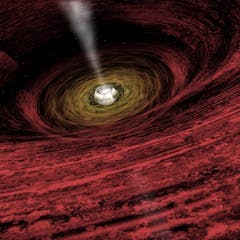
Articles on Exoplanets
Displaying 181 - 200 of 200 articles

There is excitement in astronomy and planetary science departments worldwide as the new Gemini Planet Imager, housed in the Gemini South Telescope in the Chilean Andes, turns its razor-sharp gaze to the…

Astronomers didn’t know, 20 years ago, whether planets existed around any stars other than the Sun. All that changed in 1995 with the discovery of an exoplanet orbiting the star 51 Pegasi. And by the beginning…
Water has been detected in the atmosphere of a massive, hot planet orbiting the nearby star tau Boötis. Led by Alexandra…

Planetary science is beginning to catch up with science fiction. Since the launch of the Kepler space telescope in 2009, a deluge of planets outside of our solar system has been found, with many oddball…

Two papers were published today in Nature, each independently revealing that a planet discovered by the Kepler mission is the closest thing we’ve found yet to another Earth. But don’t pack your bags just…

How will future alien scientists know whether life existed in our solar system? One method may be to sift through the planetary debris left when our sun becomes a white dwarf. Astronomers are doing just…

Thanks to the Intergovernmental Panel on Climate Change (IPCC) Fifth Assessment Report, we’ve recently heard a great deal about how the Earth’s climate is changing. The IPCC’s cautious assessment of the…
Earth will be able to support life for at least another 1.75 billion years, according to new research by astrobiologists…

Earth is the only planet in our solar system with a long-term, stable supply of liquid water – essential for the formation and evolution of all organic life. But this doesn’t mean there aren’t other pockets…

A new study of data from NASA’s Hubble telescope shows that the distant star Fomalhaut b really is a massive exoplanet and squashes claims made last year that it was just a dust cloud, researchers said…

Earlier this week, a Swiss-based team searching for planets outside our solar system (exoplanets) published a paper in Nature announcing the detection of an Earth-mass planet orbiting the star Alpha Centauri…

Over the past few months, NASA’s Kepler mission has repeatedly made headlines with announcements of new and unusual planetary systems around other stars. To name a few, we’ve had the most densely packed…
Astronomers have discovered an alien planet which could be the best candidate yet for harbouring water and possibly life…

A distant planet that made its name as the world’s first directly photographed exoplanet is at the centre of an astronomical stoush, after it veered off course and new doubts were raised about its existence…

It’s one of the most famous and evocative images in cinematic history – Luke Skywalker gazing out at the twin suns of Tatooine as they set, in the original Star Wars movie, A New Hope. Such a view would…

During a lunch in the summer of 1950, physicists Enrico Fermi, Edward Teller and Herbert York were chatting about a recent New Yorker cartoon depicting aliens abducting trash cans in flying saucers. Suddenly…

European astronomers have found 50 distant planets orbiting stars and 16 rocky “super-Earths”, planets that theoretically could support life. Expolanets, which orbit stars outside our solar system, were…

Astrophysicists have discovered black holes that formed up to 12.5 billion years ago – among the oldest examples of the phenomena ever seen. Black holes are objects in the Universe where a large amount…
A distant planet has been found to orbit its star in the “wrong” direction, challenging traditional theories of planetary…

In the late 1980s, when I was a young whipper-snapper just starting out as an astronomer, it was quite obvious some fields had an incredibly high profile and others were outré. The sexy ideas at the time…
